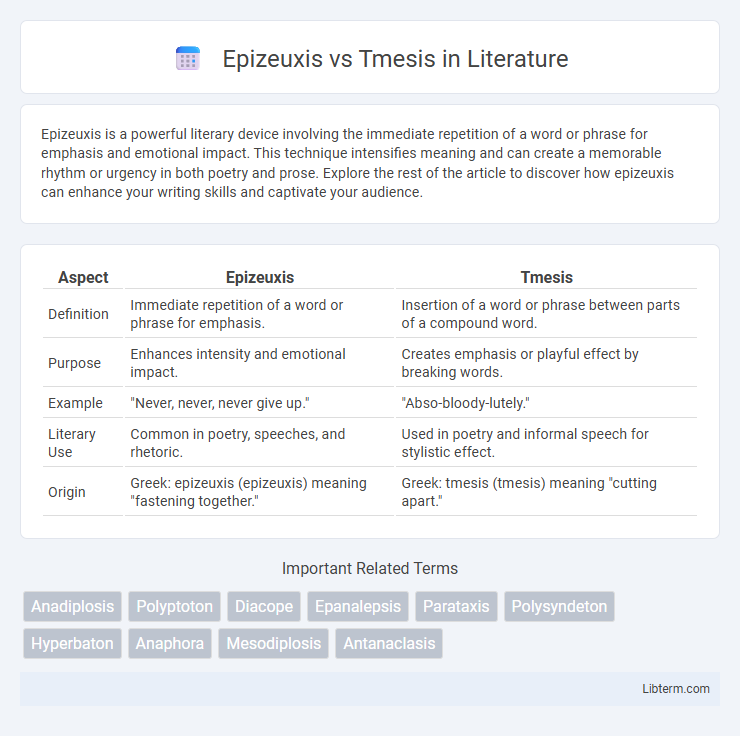Epizeuxis is a powerful literary device involving the immediate repetition of a word or phrase for emphasis and emotional impact. This technique intensifies meaning and can create a memorable rhythm or urgency in both poetry and prose. Explore the rest of the article to discover how epizeuxis can enhance your writing skills and captivate your audience.
Table of Comparison
| Aspect | Epizeuxis | Tmesis |
|---|---|---|
| Definition | Immediate repetition of a word or phrase for emphasis. | Insertion of a word or phrase between parts of a compound word. |
| Purpose | Enhances intensity and emotional impact. | Creates emphasis or playful effect by breaking words. |
| Example | "Never, never, never give up." | "Abso-bloody-lutely." |
| Literary Use | Common in poetry, speeches, and rhetoric. | Used in poetry and informal speech for stylistic effect. |
| Origin | Greek: epizeuxis (epizeuxis) meaning "fastening together." | Greek: tmesis (tmesis) meaning "cutting apart." |
Introduction to Epizeuxis and Tmesis
Epizeuxis is a rhetorical device involving the immediate repetition of a word or phrase for emphasis, enhancing the intensity and emotional impact within a sentence. Tmesis, on the other hand, involves the insertion of a word or phrase between parts of a compound word or phrase, creating a split that draws attention and adds stylistic effect. Both techniques serve to emphasize meaning but differ in structure: epizeuxis relies on repetition, while tmesis utilizes separation within words.
Defining Epizeuxis: A Closer Look
Epizeuxis is a rhetorical device characterized by the immediate repetition of a word or phrase for emphasis, such as "very, very good." This form of tautological emphasis intensifies meaning and emotional impact in speech or writing. Unlike tmesis, which splits a word by inserting another, epizeuxis centers on the uninterrupted repetition to reinforce a concept or feeling.
Exploring the Structure of Tmesis
Tmesis involves the deliberate separation of a compound word or phrase by inserting one or more words within it, showcasing a flexible syntactic structure that emphasizes specific elements. This rhetorical device contrasts with epizeuxis, which relies on immediate repetition for emphasis, while tmesis creates a fragmented yet cohesive expression. An example of tmesis is "abso-bloody-lutely," where the inserted intensifier disrupts the compound without losing its original meaning.
Epizeuxis in Classic and Modern Literature
Epizeuxis, the rapid repetition of a word or phrase for emphasis, appears prominently in both classic and modern literature to heighten emotional intensity and create rhythmic effect. Classic works like Shakespeare's "Julius Caesar" use epizeuxis to convey urgency and passion, as seen in Marc Antony's repeated "Friends, friends, Romans, countrymen," while modern authors employ it to capture contemporary speech patterns and internal monologues. This rhetorical device remains a powerful tool for amplifying sentiment and drawing reader attention through immediate verbal impact.
Tmesis: Historical and Contemporary Examples
Tmesis, an ancient rhetorical device involving the insertion of a word or phrase within another word, dates back to classical Latin and Greek literature, with examples like Virgil's "abso-bloody-lutely" illustrating its emphatic use. In contemporary contexts, Tmesis appears prominently in modern English slang and advertising slogans, such as the playful insertion in "un-freaking-believable," enhancing expressiveness and emotional impact. This device contrasts with epizeuxis, which relies on direct repetition for emphasis, making tmesis a more intricate and creative form of linguistic emphasis throughout history.
Key Differences Between Epizeuxis and Tmesis
Epizeuxis is a rhetorical device involving the immediate repetition of a word or phrase for emphasis, such as "Alone, alone, all all alone." Tmesis, in contrast, involves the insertion of a word or phrase between the parts of a compound word or phrase, often for stylistic or dramatic effect, exemplified by "fan-bloody-tastic." The key difference lies in epizeuxis's repetition of identical words in sequence versus tmesis's strategic splitting and insertion within a compound term.
Functions and Effects in Rhetoric
Epizeuxis amplifies emphasis through immediate repetition of a word or phrase, intensifying emotions and creating a memorable impact in rhetoric. Tmesis, by inserting a word within another, disrupts ordinary syntax to draw attention and showcase wit or creativity, enhancing persuasive appeal. Both devices manipulate language rhythm and structure to engage audiences and strengthen argumentation effectively.
Usage in Everyday Language
Epizeuxis involves the immediate repetition of a word or phrase for emphasis, commonly used in everyday language to express strong emotions or urgency, such as "very, very good." Tmesis, on the other hand, splits a compound word or phrase by inserting another word, often seen in informal speech or creative writing, like "abso-bloody-lutely." Both rhetorical devices enhance spoken and written communication by adding emphasis and stylistic flair.
Famous Authors and Their Preferred Stylistic Device
Shakespeare famously employed epizeuxis for dramatic emphasis, exemplified in King Lear's "Never, never, never, never." Chaucer often utilized tmesis to create rhythmic complexity and lyrical flow in Middle English verse, as seen in "what-so-ever." Modern poets like Sylvia Plath preferred epizeuxis to intensify emotional expression, contrasting with T.S. Eliot's subtle use of tmesis to disrupt syntax and evoke deeper meaning.
Conclusion: Which Device Enhances Text More?
Epizeuxis intensifies emphasis by repeating words consecutively, creating rhythmic impact and emotional resonance, while tmesis alters word structure by inserting elements within a term, adding complexity and stylistic flair. Epizeuxis often enhances clarity and urgency in text, making it more memorable and persuasive, whereas tmesis introduces playful or dramatic effects that may appeal in poetic or creative contexts. Choosing the device depends on the desired textual impact; epizeuxis generally strengthens straightforward emphasis, whereas tmesis enhances ornamental and nuanced expression.
Epizeuxis Infographic

 libterm.com
libterm.com